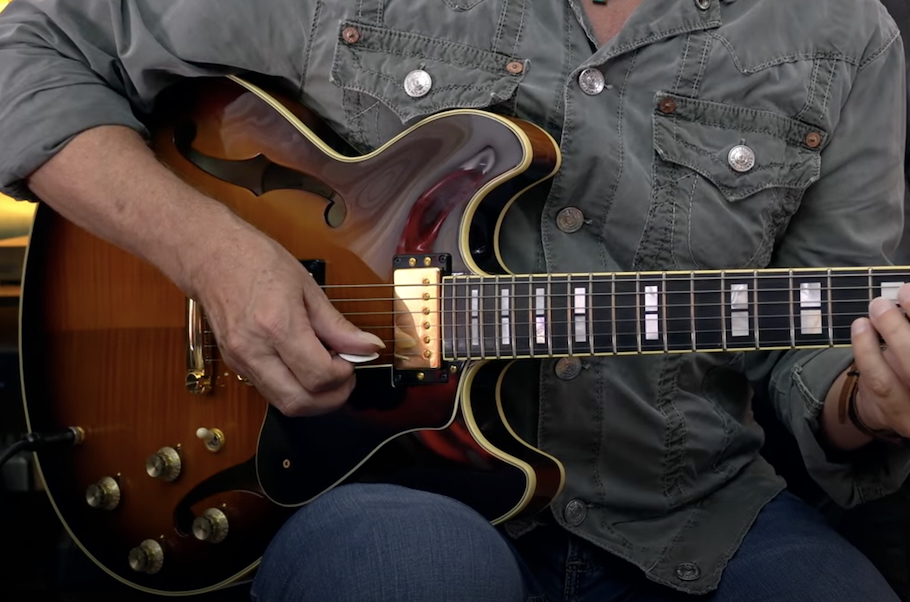How to Play Slide Guitar, Part 2
Expand your sonic possibilities with this classic technique.
In Part 1 of this two-part article, we discussed the origins of slide guitar playing as well as the different types of slides, plus guitar setup tips and the tunings that work best. Now let’s move on to basic slide playing technique.
Choose a Finger
The first step is to decide which finger to wear the slide on. There’s no right or wrong answer, although the ring finger is probably the most popular. You can find examples of great players that use the ring finger (which was favored by Duane Allman, whom we mentioned in Part 1), as well as those who favor the middle finger and the pinkie. It may take some experimentation until you find what’s most comfortable for you.
The ring and middle fingers offer you more strength and allow you to use a larger, heavier slide. However, the pinkie has one huge, practical advantage: you can play chords with your remaining three fingers in-between your slide parts. Your ability to play chords is much more limited if you wear a slide on the middle or ring finger.
Basic Technique
One significant way that slide playing differs from conventional guitar playing is that you place the slide over the fret itself, rather than in the space between frets. With slide playing, intonation (that is, the ability to play exactly in tune) is crucial. One of the earliest things you should practice is proper slide placement, so that notes aren’t a little flat or a little sharp. You also want to approach as many notes as you can from either below or above, so that you’re sliding into the note (typically from either a half or whole step away) instead of just hitting it dead on.

Another part of slide technique that will help you with both intonation and expressiveness is vibrato. When you sustain a note, you should create a vibrato by quickly moving the slide side-to-side over the fret. In the audio example below, you’ll hear the same phrase twice. The first time, there’s no vibrato on the sustaining last note; the second time, there is. As you can hear, the difference is substantial!
Most electric slide playing is done through amps, with the gain turned high and/or with the use of an overdrive or distortion pedal. You’ll find you’ll get a lot more sustain that way. However, for learning, you should also practice with clean sounds, as they’ll help you hear what you’re doing more clearly. The rule of thumb is simple: if you can make it sound good clean, it’ll sound even better dirty.
Taming Stray Notes
Another fundamental technique of slide playing is dampening (i.e., muting) the strings that aren’t being played. If you don’t dampen effectively, you’ll not only hear notes you don’t want, but there will be lots of noise from the slide running over the strings and frets.
Here’s an easy way to practice dampening. First, place your slide over the third and fourth strings at the 7th fret. Play those two strings and slide up to the 12th fret. Now take the fingers on your left hand that are behind the slide and lay them down lightly on the strings, then try playing it again. The notes should sound clearer because the non-used strings are being muted by your fingers behind the slide. (If you’re wearing the slide on your pinkie, use your first and middle fingers for dampening.)
In this next audio example, you’ll hear the same riff played twice: the first time without any dampening and the second time with dampening. Note the difference in clarity:
Most slide players pluck the strings with their fingers, rather than using a flat pick. This allows you to get a lot more control over which notes you play, plus you can take advantage of thumb-and-finger combinations that are impossible with a flat pick. What’s more, you can use some of your right-hand fingers, along with the back of the palm of your hand, to do additional dampening of the strings, as shown in the photo below. This will make your tone even cleaner.

Bear in mind that we’ve only covered the basics here. There are plenty of online videos that can take you a lot further, so check them out to learn more. Good luck and happy sliding!
Banner image by Maxim Fiyavchuk on Unsplash. All other photographs courtesy of the author.
Click here for more information about Yamaha guitars.















